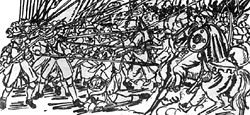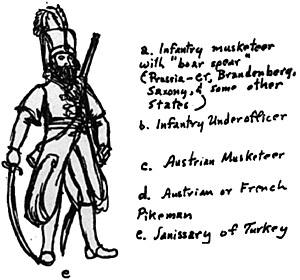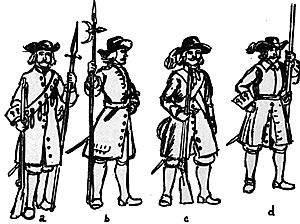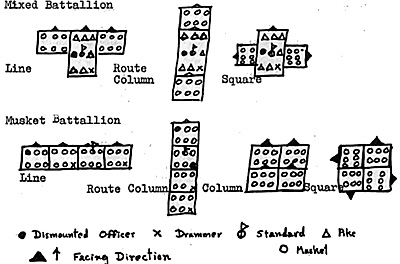 Having been dragooned into an interest in the 1683 period by the availability of some excellent new 20mm figures (Editions Bilaubre Avenue General de Gaulle, La Gareene Colombes, France) and becoming interested furthur in the 1670-1690 series offered by Gerhard Tobinnus, it has fallen my lot to dabble in the late XVII Century as both a wargamer and a collector.
Having been dragooned into an interest in the 1683 period by the availability of some excellent new 20mm figures (Editions Bilaubre Avenue General de Gaulle, La Gareene Colombes, France) and becoming interested furthur in the 1670-1690 series offered by Gerhard Tobinnus, it has fallen my lot to dabble in the late XVII Century as both a wargamer and a collector.
It takes very little to become an expert in the period over here. I am currently tied with Dick Bryant (editor of the New England Wargames Club Courier) for having played most late XVII Century wargames known to have occurred in the United States. Dick, who on his first such adventure, took some photographs of the confusion, was caught on business trips to the Washington area and became the victim in two successive experiments--the first using Neville Dickenson's English Civil War rules, and the second using an evolutionary variant of the Kriegspiel series.
Neville Dickenson's rules were far from being as impossible as strange rules usually seem to me. Even so, neither of us knew much about them, so several encounters had to be played over-not the least embarassing of which was the opening charge of Dick's Polish Hussars (read "Lobsters" in Dickenson's rules) who appeared to have been routed with two casualties until we checked more closely and found that, with no morale throw called fort and their inordinately high saving throw factor, the rascals had escaped unscathed and massacred my tartars to boot!
Confusion struck again when my officer-less Turks bolted on every other exchange of shots, even though they were doing a lot more firing, and even somewhat more hitting. It in very important with those rules to start with the regulation quota of officers, standards, musicians, and the like.
 At any rate, my high level of wargame experience notwithstanding, I never display my Turks without some wit explaining to me that yellow shoes were worn only by Veterans, and asking why the plumes of my Janissaries are white instead of painted properly to represent peacock feathers. The answer, of course, is that I don't have a color TV so I don't know what peacock feathers are supposed to look like: Not so many years ago recall that one member of the NCMC was painting a Hungarian Guardsman circa 1900 and started a rage of curiosity concerning the colors of the pelt of a European panther. We left the keeper of the Metropolitan Zoo alone after that until I found it necessary to check on the colors of an Imperial Eagle (not the brass do-dad on the standard, but a European bird so known because only an Emperor was supposed to be able to use him in hunting, a serious handicap because Eagles are big and clumsy and much inferior to falcons, even if you have a retainer to carry them around). I was of course, trying to paint some Polish Hussars. Anyway, if you want to be told by a bird keeper that you must be some kind of a nut, call up and ask what kind of peacock feathers would it be easiest for a Janissary working out of Istanbul to get his hands on.
At any rate, my high level of wargame experience notwithstanding, I never display my Turks without some wit explaining to me that yellow shoes were worn only by Veterans, and asking why the plumes of my Janissaries are white instead of painted properly to represent peacock feathers. The answer, of course, is that I don't have a color TV so I don't know what peacock feathers are supposed to look like: Not so many years ago recall that one member of the NCMC was painting a Hungarian Guardsman circa 1900 and started a rage of curiosity concerning the colors of the pelt of a European panther. We left the keeper of the Metropolitan Zoo alone after that until I found it necessary to check on the colors of an Imperial Eagle (not the brass do-dad on the standard, but a European bird so known because only an Emperor was supposed to be able to use him in hunting, a serious handicap because Eagles are big and clumsy and much inferior to falcons, even if you have a retainer to carry them around). I was of course, trying to paint some Polish Hussars. Anyway, if you want to be told by a bird keeper that you must be some kind of a nut, call up and ask what kind of peacock feathers would it be easiest for a Janissary working out of Istanbul to get his hands on.
 European uniforms are a trifle easier French troops, mostly gray, Austrians, a slightly lighter grey, Saxons grey except for the guard, which had red coats, Bavarians grey with aspirations of getting blue coats one of these days, Savoy- a regiment of dragoons in red and a regiment in blue, each trimmed in the opposite color, according to a color plate Aram was kind enough to lend me.
European uniforms are a trifle easier French troops, mostly gray, Austrians, a slightly lighter grey, Saxons grey except for the guard, which had red coats, Bavarians grey with aspirations of getting blue coats one of these days, Savoy- a regiment of dragoons in red and a regiment in blue, each trimmed in the opposite color, according to a color plate Aram was kind enough to lend me.
However, according to some notes on Prince Eugene quated to me by Dennis Largesse later on, that worth (Eugene, not Dennis) had a habit of gambling heavily and most of the troops worked out in grey, the fancier stuff awaiting a favorable turn in the princely fortunes.
Artillery, in the Austrian service, seems to have begun the period in--you guessed it, grey! However, some time before the turn of the century they may have adopted the brown so popular in that service for later periods.
At any rate, the current statue of my own experiments into with the period is as follows:
| Melee Value and Mounting of Figures by Base | ||||
|---|---|---|---|---|
| Type | Number of Figures per base | Movement | Melee value | Impetus |
| Polish Hussars | 6 | 3 | 6 | 2 |
| Cuirassiers | 6 | 3 | 6 | 1 |
| Pancernis, Spahis, Dragoons * | 3 | 3 | 2 | 1 |
| Light Horse | 3 | 4 | 1 | 1 |
| Pikemen | 9 | 1 | 4 | 1 |
| Musketeers Scimitar/Axe | 6 | 1 | 1/1.5** | 1 |
| Bayonet/Boar Spear | 6 | 1 | 1/1.5** | 1 |
* In this period I seem to recall reading in a very unreliable source that the Savoy Dragoons, which is all I've painted yet, charged home. A more likely notion is that European Dragoons of the period would fight as light horse mounted and as line musketeers on foot, but with full musket range mounted at the halt.
** Some years ago various authors who were working on rules for ancient warfare gave pointed weapons of heavy infantry a marked edge against cavalry, but not so much melee value against infantry. It seems to me likely that a hedge of boar spears or plug bayonets would be more useful against a mounted charge, but less effective against enemy infantry in a melee thus a bass of hovers rate 1 against horse, 1.5 against foot, and pole-arms vice-versa. In the event of a combined attack on a formation of either by horse and foot, the attackers would benefit from the confusion and musket bases would assume their lowest value.
Musketry: Musketry may be delivered by musket bases halted or taking normal movement. Maximum range is 3 polygons or 15". A 5-6 on the the scores a hit up to 2 polygons or 10", a 6 at 3 or 15". The lack of a higher kill rate at point blank I fondly attribute to the fact that none of the types of musketeers then available was really up to close fighting until he had either put a plug in the barrel, drawn sword, or levelled his spear, thus his attention would have been divided when the enemy was up close.
Grenadiers: Roughly every 10th man was apparently a grenadier in each Austrian company. They were light infantry who fought in loose order-since the fused bomb had a tendency to go off at the wrong moment, and it was not safe, to stand close to a grenadier. Grenadiers tended in most armies to be armed, as well as with the grenades, with a short rifle, or rather, musket, known as a fusee as well as sword, occassional pistols, and perhaps; a bayonet. Grenadiers for this game, are mounted on bases of 3 figures and, on entering a melee will not only fire a normal shot but get an extra die from which a 4-5-6 will extract a casualty, and a 6, if it occurs, produces disorder in the attacked unit for one turn. If a 1 is rolled. the grenadiers do not add their melee value (of 1 point) to the attack, and suffer I casualty(this feature involves consideration of the faulty fuse.) Ordinary musketry of a defending unit, if a 6 is rolled in the last turn of an attack, is sufficient to stop a charge.
Mounted Gunfire: Mounted cavalry =7 fire carbines at 2 distance units with a 6 in the second and a 5 or a 6 in the first required to hit(Pancernis, Spahis, light horse, and dragoons.) Heavy cavalry may fire pistols at point blank with a 4-5-6 required to hit and a 6 required to produce disorder. Cavalry engaged in either type of fire attack may not claim impetus. (The types of cavalry able to fire at carbine range may also use pistols.) A frontal fire Attack will only cross the trotting range of 2 polygons.
Dragoons, Spahis, and other carbineers and mounted archers may execute an attack involving a 30 degree turn in the midst of a gallop move and fire at the closest point to the target, receiving whatever return fire would bear on that point. This will leave the troopers so attacking in d isorder for a turn, but, to reach them, a cavalry force moving second (alternate sides of the field moving first as in the Wargame) -- an attacker must be able to reach their final position.
Organization: The actual organization of the Polish cavalry has already been covered. With the masses of troops which may be involved, for example, in the Vienna campaign of 1683, 1 fudge a lot, but each base of Polish Hussars is used for 2 banners to which a like number of Valaques, Pancernis, etc. may be assinged to form a Pulk. Roughly 3 figures are used to represent 100 to 150.
Turkish troops seem to have been organized on decimal units, e.g. 100, 1,000, 10,000 men in units which is fairly close, considering the superiority of paper numbers to actual numbers, to a 4 base unit of Turkish musketeers.
Austria used battallions of a theoretical strength of 1,000 with at least 2 to the regiment. While I now use (700) about 6 pikes, 1 standard, 1 drummer, 1 foot officer, and 12 muskets with the cadre filling out the pike bass to 9 figures this is admittedly pretty weak, especially as 4 bases of musketeer can occupy a polygon, and they, get an extra 3 men (Saxons, some Barbarians, etc.) no more brilliant scheme has occured to me at this time.
Artillery: Artillery is somewhat of a chore in this period, as James Hinds' account of the available types will indicate. My own notion is to merely classify the major weapons as heavy, which may fire every other turn or 1 shot per 2 gun battery per turn, and must take 2 turns to limber, or 2 turns to set up in battery, but has a range and general effect equal to a Napoleonic field piece when it fires. These may be used for siege work, light field pieces having the movement capacity of Napoleonic field guns, but the range and fire effect of horse artillery. As for battallion guns, gallopers, and other radical nonsense, make up your own rules. I'll worry with that if I ever get around to making one.
While artillery in the field was widely used and often effective,the heavier field pieces, as in the English Civil War and 30 Years War. were not usually expected to move around much after the battle had started.
Formations: Hampered by the somewhat stylized base structure inherited with the figurines from my French friends, I have been at something of a loss to come up with altogether satisfactory infantry formations. However, with hasty improvisation, I suggest the following:

Back to The Armchair General Vol. 2 No. 7 Table of Contents
Back to The Armchair General List of Issues
Back to MagWeb Master Magazine List
© Copyright 1970 by Pat Condray
This article appears in MagWeb (Magazine Web) on the Internet World Wide Web. Other military history articles and gaming articles are available at http://www.magweb.com
